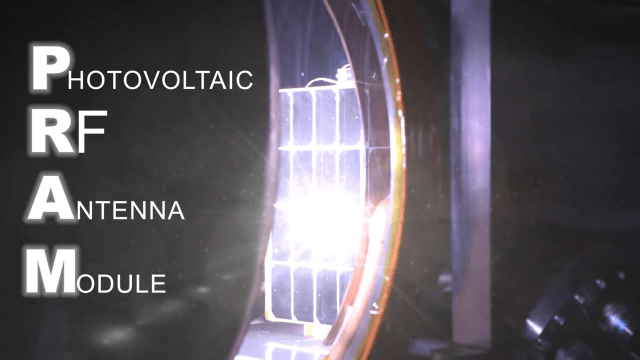Here is a completely normal and totally not-nefarious thing that is happening: Scientists from the Pentagon sent a solar panel about the size of a pizza box up to space to test if it’s possible to send extraterrestrial electricity back to Earth.
This solar panel is officially called the Photovoltaic Radiofrequency Antenna Module (PRAM), and it’s designed to capture the powerful blue light in space that doesn’t pass through the atmosphere. Navy scientists launched it last May using a mysterious drone called the X-37B, and it’s currently circling the Earth every 90 minutes. So right now, as I’m typing, there is a little solar panel looping the planet because the Department of Defence wanted to put it there. Somehow, this is not an episode of the X-Files, it is real life.
According to CNN, this week, the Pentagon determined their, uh, little PRAM experiment was successful — the thing does indeed capture power. The scientists found it can generate 10 watts of energy, which is enough to power an iPad, though they didn’t test out the transmission back to Earth part via microwaves yet. You have to wonder, how much fossil fuel energy did they expend to find that out? I mean, they didn’t send the X-37B up to space using wind power, it runs on jet fuel.
The scientists want to send dozens of these panels to orbit the Earth, and they say if they scale up the project, it could produce enough electricity to fuel a whole city. But as far as I can tell, no one has been clamoring for space power. Myself and the other 99.9% of humanity would be perfectly happy with solar, wind, and other clean energy generated right here on Earth.
If these Defence Department scientists successfully get more of these panels into orbit, there’s no telling what horrors the nation will use them for. After all, the Pentagon is the least-regulated part of the federal government, and the agency says they can supply energy to any part of Earth. The scientists in charge of the program have said it could be used to help in places struck by natural disasters. And the Department of Defence has developed or helped developed some things with civilian applications, notably the internet.
But then again, the researchers also say it could be used to power military bases. Other applications they’ve listed include keeping the Navy’s ship moving around the ocean, developing synthetic fuels, and powering drones to keep “flying indefinitely,” which sounds downright horrifying.
The Department of Defence has been behind research into direct energy weapons, spying plants, “spacetime modification weapon” that would “make the Hydrogen bomb seem more like a firecracker, in comparison.” So forgive if I’m a little sceptical. But hey, maybe I’m wrong, and this is all a ploy to bring free power to countries where the U.S. military destroyed the power grid. Or maybe we’ll do another forever war but make it green! Great! One way the technology won’t likely be used: as a space laser because it would be “exceedingly difficult” to assemble, particularly in a discreet manner, according to what the scientists told CNN. So at least we can put that conspiracy to bed for Rep. Marjorie Taylor Greene.
At the very least, PRAM a pretty, um, weird thing to spend resources on, even for an agency with the largest budget in the government. To be clear, I don’t know how much it cost to launch PRAM, but as a project developer told CNN, “building hardware for space is expensive.” So basically, U.S. officials won’t throw down for a Green New Deal or even ramp up the deployment of renewable energy technology we already have that would come with huge benefits, but we’ve got money to spend on testing magic pizza box panels in outer space? Got it.
